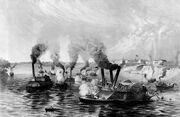(Created page with "'''CSS <span style="font-style: italic;">GENERAL BEAUREGARD</span> (1861)''' [[File:Memphis_h42367.jpg|thumb|Period sketch of the Battle of Memphis. Beauregard is in the right ce...") |
(No difference)
|
Revision as of 06:05, 31 October 2011
CSS GENERAL BEAUREGARD (1861)

Period sketch of the Battle of Memphis. Beauregard is in the right center of the image, being rammed by USS Monarch.
Built: Algiers, Louisiana
Commissioned: April, 1862
Service: River Defense Fleet, 1862
Home Port: Memphis, Tennessee
Dimensions: Unknown; displaced around 461 tons.
Armor: Cottonclad
Armament: 1x42lb Smoothebore, 4x8" Smoothebores
Engines: Dual Paddlewheel
Speed: Unknown;estimated 9-10 Knots
Crew: Unknown
Fate: Rammed and sunk at the Battle of Memphis, June 6th 1862.
Summary
General Beauregard , formerly the New Orleans steamer Ocean, was acquired by the Confederate States Navy in January, 1862, and quickly converted into a cottonclad sidewheel ram. She was one of the better armed vessels in the River Defense Fleet, and carried a powerful suite of weaponry, well suited to her intended roll.
General Beauregard spent her career in the defense of the Upper Mississippi, most notably at the Battle of Plum Point. While she was unable to position herself to successfully ram any of the Union vessels present, she kept up a steady pace of fire with her 8" smoothebores, described as "brave" in the face of heavy enemy fire.
Later, at the Battle of Memphis, she acted equally bravely, challenging the powerful ironclad USS Benton and firing a close range shot with her 42lb smoothebore. The Benton replied, striking Beauregard's boiler and seriously injuring several of the crew. Shortly thereafter, the vessel began to take on water. Many of those injured by the exploding boiler were rescued by the Benton. The remainder of the crew remained aboard the Beauregard attempting to save her until she was rammed, forced to surrender, and then taken in tow by USS Monarch, during which time she finally sank in relatively shallow water. Most of her remaining crew was rescued and taken prisoner by the Monarch.